Pickleball is more than just a game; it’s a fusion of joy, strategy, and community engagement. Unlike the common racquet sports known to many, pickleball uniquely blends elements of tennis, badminton, and table tennis, presenting a game steeped in fun, competitiveness, and accessibility. Originating from Bainbridge Island in Washington in 1965, this game has transcended its casual backyard play roots to become one of the fastest-growing sports in the United States. Its appeal spans all age groups and skill levels, largely due to its simplicity and the low-impact nature of the game. Whether played indoors or outdoors, pickleball has become synonymous with social interaction and quality physical exercise, making it a staple in community centers, gymnasiums, and parks across the nation.
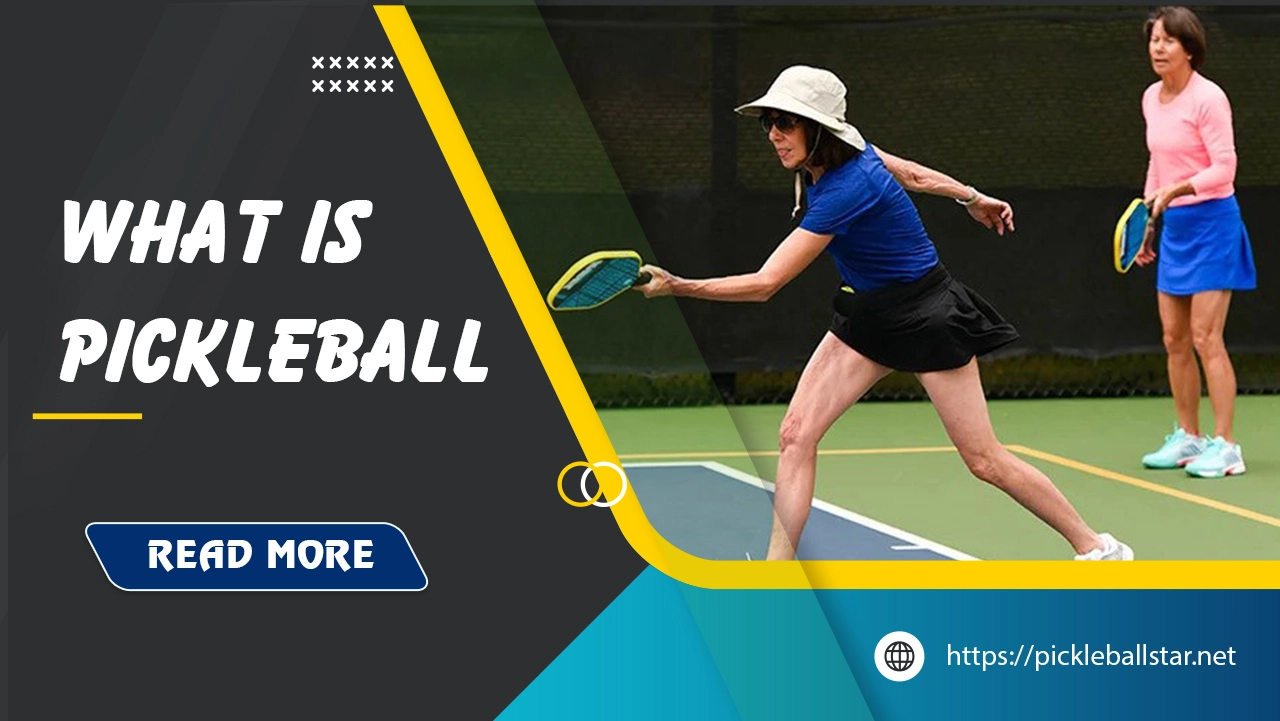
History of Pickleball
The history of pickleball is a story of creativity, communal enjoyment, and evolution. Born out of a need to entertain a family, the game has grown exponentially, becoming a professional sport enjoyed by millions. From its humble beginnings in the 1960s to being a part of national tournaments today, pickleball reflects a journey marked by innovation and a genuine love for the game. Understanding its origins and transformations paints a comprehensive picture of this beloved sport.
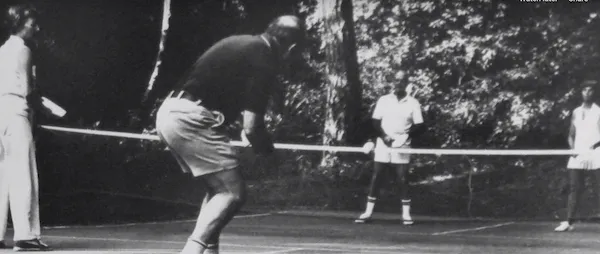
Origins and creation
Pickleball originated in the summer of 1965 on Bainbridge Island, Washington, when three Joel Pritchard, Bill Bell, and Barney McCallum sought to create a unique and engaging game for their families. The concept was to combine elements from badminton, tennis, and ping-pong to design an accessible sport that could be enjoyed by players of all ages and skill levels. Initially, the game was played using a makeshift setup, consisting of a badminton court, a lowered net, wooden paddles, and a perforated plastic ball similar to those used in wiffle ball. The court dimensions they established were 20 x 44 feet, which remain standardized in modern pickleball play. As the game quickly gained popularity among local residents, it evolved from a simple backyard pastime to a widely embraced sport, with nearly 1,000 players participating in the United States by 1970.
The name “pickleball” has its share of myths regarding its origins. One popular story suggests it was named after the Pritchard family’s dog, Pickles, who enjoyed chasing the wiffle balls. Alternatively, it has been theorized that the term derives from the “pickle boat,” a term used in crew where oarsmen come from various boats to make a crew. Regardless of its naming origins, the sport’s charm and accessibility have contributed to its broad appeal.

By 1976, the first official pickleball tournament was organized, and in 1984, the USA Pickleball Association (USAPA) was established to promote the sport and create standardized rules. The growth of pickleball continued through the 1980s and onward, leading to its recognition as one of the fastest-growing sports in the United States, attracting millions of players each year.
Today, pickleball is celebrated as an inclusive sport that encourages social interaction among players, making it a popular choice in community centers, schools, and parks across the country as well as globally. The evolution of pickleball into a recognized sport reflects its origins of creativity, community engagement, and a focus on enjoyment.
Evolution of the Game
Pickleball is a racquet sport that combines elements of tennis, badminton, and table tennis. It was invented in the summer of 1965 on Bainbridge Island, Washington, by Joel Pritchard, Bill Bell, and Barney McCallum. Initially created to entertain their families, the game utilized a badminton court, ping-pong paddles, and a perforated plastic ball, quickly gaining popularity within their social circle and expanding to a broader audience over the decades.
The evolution of pickleball has been marked by several significant milestones. Following its invention, the first permanent pickleball court was constructed in 1967. In 1972, a corporation was formed to protect the sport’s rights, and the first organized tournament was held in 1976 at the South Center Athletic Club in Tukwila, Washington. The game continued to grow, leading to the formation of the United States Amateur Pickleball Association (USAPA) in 1984, which standardized the rules and regulations of the game and promoted its advancement nationally.

From the late 1990s onward, pickleball witnessed a substantial increase in its popularity. By 2003, there were only 39 known pickleball locations in North America, but this number surged to over 8,000 by 2021, reflecting the sport’s accessibility to people of all ages and skill levels. Notable factors contributing to the growth of pickleball include its appeal to seniors seeking low-impact exercise, the game’s social nature, and increased media exposure through televised tournaments and online platforms. The establishment of professional pickleball tours and high-profile competitions further solidified the sport’s status.
In the United States, pickleball has become a widespread phenomenon, with its popularity continuing to rise. As of 2023, there were approximately 8.9 million players across the nation, positioning pickleball as one of the fastest-growing sports. Community engagement through local clubs, activities at retirement communities, and national competitions have nurtured a vibrant pickleball community, serving to attract both new participants and seasoned players.
The history and ongoing evolution of pickleball illustrate a trajectory of growth from a simple backyard game to a globally recognized sport, celebrated for its inclusivity, accessibility, and dynamic gameplay.
Growth in Popularity
The proliferation of pickleball in recent years has been nothing short of remarkable. Spanning across various demographics, pickleball’s rise has been fueled by several factors, including its accessibility, the engaged community, and the structured efforts to promote the sport.
One pivotal point in the popularity surge is the increasing media coverage. With the introduction of professional pickleball tours and leagues, tournaments have gained broader exposure on televised sports channels and social media platforms. This visibility has not only attracted new players but has also drawn in sponsors and endorsements, elevating the sport’s status. The USA Pickleball Association (USAPA) has played a significant role in promoting pickleball, organizing events, and standardizing the rules to create a unified structure for the game.
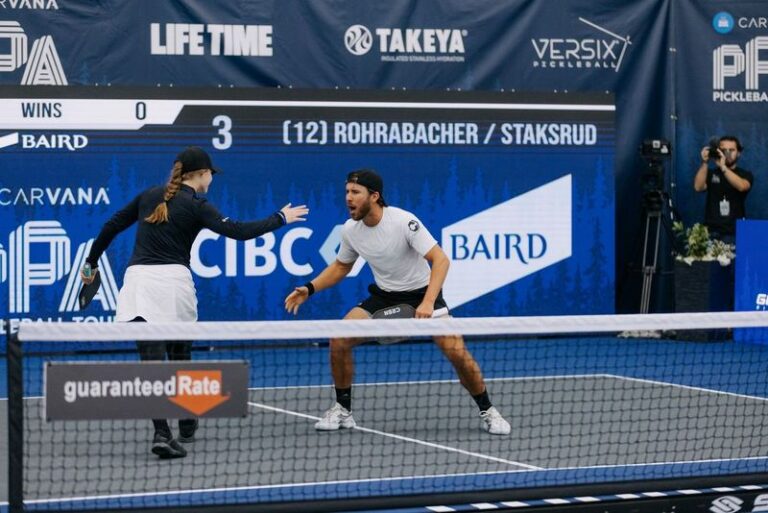
Moreover, pickleball’s appeal to older adults seeking a low-impact yet engaging physical activity cannot be overstated. Reports show that a significant percentage of pickleball players are aged 55 and above. This demographic has found pickleball to be an ideal blend of social interaction and physical exercise, providing cardiovascular health benefits without the strain associated with high-impact sports like tennis. The game’s simplicity and the modest equipment investment required make it an attractive option for those exploring new recreational activities.
Additionally, community engagement and local initiatives have spurred the sport’s growth. Many neighborhoods, particularly in retirement communities, have incorporated pickleball courts into their amenities, recognizing the social and physical benefits it offers. Schools have also adopted pickleball in physical education curricula, introducing younger generations to the sport and ensuring its continuity.
The USA stats reveal the scope of its growth: in 2010, there were only about 1000 known pickleball locations, which has swelled to over 9,000 locations by 2023. This rapid growth is a testament to the game’s widespread acceptance and popularity.
Lastly, the affordability of playing pickleball, in contrast to other sports that require costly equipment or membership fees, has also contributed to its surge in popularity. The game’s entry-level cost, combined with public courts affordable or free access, has made it uniquely attractive.
In summary, the game of pickleball has seen exponential growth due to factors such as media exposure, community engagement, demographic appeal, and economic accessibility. Its rise from a family pastime to a widely played sport demonstrates its universal appeal and staying power.
Rules and regulations
The rules and regulations governing pickleball, particularly court dimensions, are outlined by the USA Pickleball Association (USAPA). The official dimensions for a regulation pickleball court are as follows:
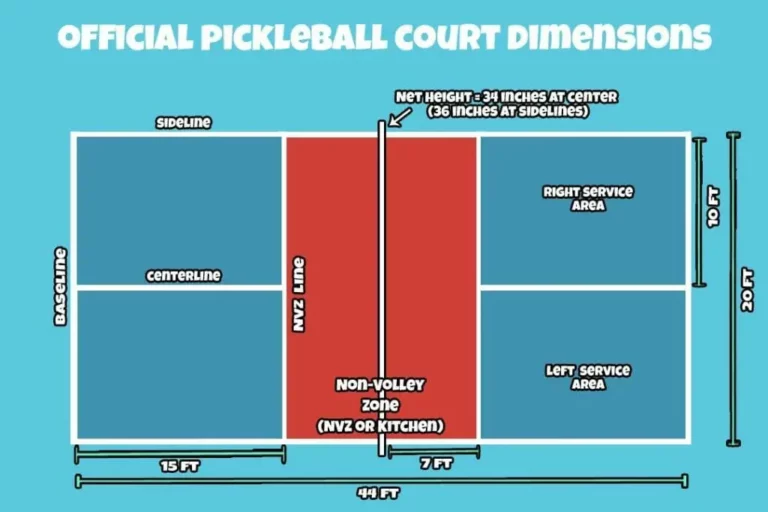
- Length: 44 feet (13.41 meters)
- Width: 20 feet (6.1 meters)
- Total Area: A standard pickleball court covers an area of 880 square feet (81.7 square meters)
Having a firm grasp of these rules is crucial for ensuring fair play and enhancing enjoyment. These regulations standardize the game, making it consistent for players across different venues.
Court dimensions
Pickleball is played on a court similar in size to a doubles badminton court, yet distinctive in its lines and markings.
- Length: 44 feet
- Width: 20 feet
- Net Height: 36 inches at the sidelines, 34 inches at the center
- Non-Volley Zone: 7 feet from the net on each side
- Court Layout: Includes baselines, sidelines, a centerline, and a non-volley zone line.
Key Features of a Pickleball Court
- Net Height: The net is set at a height of 36 inches (0.914 meters) at the sidelines and 34 inches (0.864 meters) at the center.
- Non-Volley Zone: This area, also known as the kitchen, extends 7 feet (2.13 meters) from the net on both sides, totaling a width of 14 feet where players cannot volley the ball.
- Service Areas: There are designated service areas on each side of the net. Each service area measures 15 feet (4.57 meters) from the net and is bounded by the centerline and sideline.
Court Layout
The court is divided into the following segments:
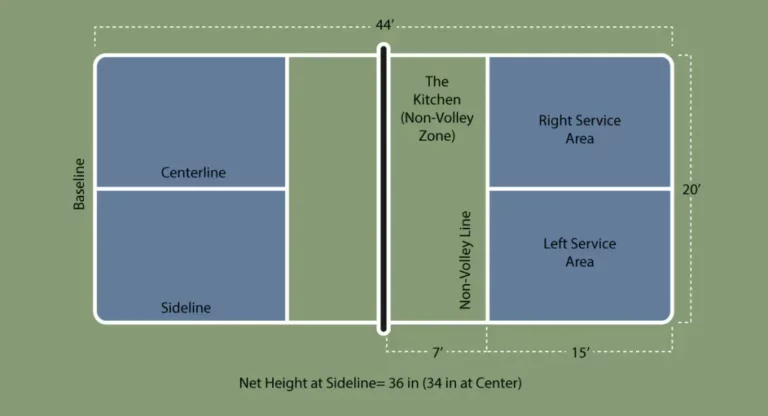
- Baselines: These lines run parallel to the net and mark the back boundaries of the court.
- Sidelines: The outer sides of the court run perpendicular to the net and define the width.
- Centerline: This line divides the court into right and left service areas and is important during service plays.
- Non-volley zone line: Marks the boundary of the non-volley zone, situated 7 feet from the net on each side.
Construction and Surfacing
Pickleball courts can be constructed indoors or outdoors, typically on smooth and flat surfaces such as asphalt, concrete, synthetic materials, or modular sports tiles. When constructing a new court, it’s crucial to follow the court dimension layouts to ensure compliance with USAPA standards.
Accessibility and Compliance
The Americans with Disabilities Act (ADA) standards should be considered when designing a pickleball court, ensuring that facilities are accessible for all players, which includes incorporating ramps and ensuring clear pathways around the playing area.
Summary
The fundamental dimensions and layout requirements for pickleball courts create a standardized playing environment that fosters fair play and competitive balance. These standards play an essential role in ensuring that matches are enjoyable and meet the necessary regulations required by governing bodies in the U.S.
Scoring System
The scoring system in pickleball follows unique rules and regulations that distinguish it from other racquet sports. Here’s a detailed overview:
Point Allocation: Points can only be scored by the serving team. If the serving team wins a rally, they earn a point; if they lose, no points are scored, and the serve rotates to the next player on the team or to the opposing team if both players have served. Games are typically played to 11 points, with players required to lead by at least 2 points to win. Tournaments may also have games that go to 15 or 21 points.
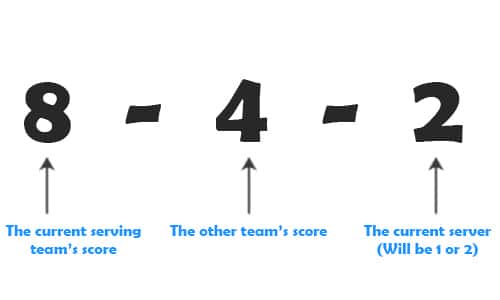
Score Calling: Before each serve, the server calls out the score with three numbers: their own score, the opposing team’s score, and their server number (1 or 2 for doubles play). For example, “4-3-1” indicates the serving team has 4 points, the receiving team has 3 points, and the first server is serving.
Rotation: In doubles play, each player on the serving team serves once before the serve passes to the opposing team upon a fault. The first server starts from the right-hand court and switches sides after each point won. If both players on a team lose their serves, a side-out occurs, allowing the other team to serve.
Game Structure: Matches are usually played in a best-of-three format, requiring teams to win two games to claim victory.
Equipment Requirements
The equipment used in pickleball is specialized to enhance the gameplay experience. Here’s a detailed breakdown:
- Paddle: Pickleball paddles are smaller than tennis rackets but larger than table tennis paddles. They are made from a variety of materials including wood, composite, or graphite. The choice of paddle can affect gameplay, especially for beginners who are advised to start with more affordable options.
- Ball: The ball used in pickleball resembles a wiffle ball made of durable plastic, with holes designed for aerodynamics. There are two types of balls: indoor balls with larger holes for softer play and outdoor balls with smaller holes designed to withstand wind.
- Net: The net measures 22 feet wide and has a height of 34 inches at the center and 36 inches at the sides. The net must be made from durable materials suitable for regular gameplay.
- Court: A standard pickleball court measures 20 feet wide by 44 feet long, divided into service areas and a non-volley zone (the kitchen) that is 7 feet deep on both sides of the net. This smaller court size promotes a more engaging and less physically demanding game compared to tennis.
Overview of Pickleball
Pickleball is a paddle sport that combines elements from tennis, badminton, and table tennis. Played both indoors and outdoors, it has gained popularity for its accessibility and appeal to all ages and skill levels. The game emphasizes both fun and competitive spirit, making it suitable for casual play as well as serious tournaments.
With these rules and equipment specifications, individuals interested in playing pickleball in the United States can fully prepare for an engaging and enjoyable experience.
How to play pickleball
Pickleball is a paddle sport that merges elements of tennis, badminton, and ping-pong, making it suitable for players of all ages and skill levels. The game is played on a court similar in size to a doubles badminton court, with specific dimensions being 20 feet wide and 44 feet long, and a net height of 36 inches at the sidelines and 34 inches at the center.
Basic Gameplay Mechanics
- Starting the Game: A pickleball game begins with a serve from the player on the right side of the court, who must serve diagonally to the opponent’s service area. The serve must be executed underhand, and players have the option to hit the ball out of the air or after a bounce.
- The Double Bounce Rule: After the serve, both teams must allow the ball to bounce once on their side before returning it. This establishes the “double bounce rule,” requiring each team to let the ball bounce before playing it.
- Non-Volley Zone: The area within 7 feet of the net is known as the non-volley zone or kitchen. Players cannot hit the ball out of the air while standing in this zone, which encourages strategic play and positioning.
- Scoring: Points can only be scored by the serving team, and games are typically played to 11 points, requiring a two-point advantage to win. The score is announced as three numbers: the serving team’s score, the receiving team’s score, and the server number, indicating which server it is in the rotation.
- Game Formats: Pickleball can be played in either singles (1 vs. 1) or doubles (2 vs. 2) formats. Most recreational play occurs in doubles, where teamwork and positioning are crucial for success.
- Faults: A fault occurs when a player fails to follow the rules of serving, returns shots, or positioning. Common faults include serving out of bounds, hitting the ball into the net, stepping into the non-volley zone while volleying, or violating the double bounce rule.
Strategies for Beginners
- Serve Deep: When serving, aim to hit the ball deep into your opponent’s court. This strategy pushes your opponent toward the baseline, making it harder for them to return the serve effectively.
- Master the Third Shot Drop: After the serve and the opponent’s return, the third shot is crucial. Instead of hitting hard, focus on a soft drop shot that lands in the opponent’s non-volley zone (the kitchen). This gives you time to move to the kitchen line to prepare for the next shot.
- Positioning at the Kitchen Line: Stay stable at the kitchen line while dinking. Maintain a strong stance (side-to-side movement is preferable) to enhance your balance and shot accuracy. Avoid moving erratically, which can lead to mistakes.
- Controlled Swings: Avoid taking big swings, especially for high balls. Instead, utilize a “punch” technique with shorter, more controlled swings to increase your accuracy and reduce errors.
- Keep Your Paddle Ready: Always keep your paddle in a ready position, particularly at the kitchen line. By positioning it just below your face, you’re prepared to respond quickly to incoming shots.
- Observation and Feedback: Remain open to feedback from more experienced players. Observing how they play can provide valuable insights that accelerate your learning process.
Common Mistakes to Avoid
- Serving and Stepping In: After serving, do not step into the court immediately. This can put you out of position for the return, especially if your opponent returns a deep shot. Instead, serve and stay back to allow for a better setup for the next play.
- Relying Too Much on Hard Hits: Beginners often try to hit the ball too hard, especially on the third shot. Focus on making consistent, strategic shots rather than powerful ones. Employing a third-shot drop can improve your game significantly.
- Kitchen Faults: Many newcomers struggle with the non-volley zone (kitchen) rules. Remember, you cannot volley inside the kitchen. Familiarize yourself with these rules to avoid unnecessary faults.
- Inconsistent Paddle Position: Keep your paddle in a ready position rather than dropping it low. An inconsistent paddle position can lead to slow reactions and missed opportunities.
- Ignoring Centerline Opportunities: If you’re a forehand player, take shots that come down the centerline. This enhances your chances of a powerful return, as your forehand is typically stronger.
Summary
Understanding the basics and strategies of how to play pickleball, along with being aware of common mistakes, can greatly enhance your enjoyment and success in the game. Focus on refining your individual skills while remaining engaged with the broader pickleball community to continuously improve.
Health benefits of playing pickleball
Playing pickleball offers numerous health benefits, making it an ideal sport for various age groups and fitness levels. Its low-impact nature and enjoyable gameplay help promote a healthy lifestyle while fostering social interaction.
Cardiovascular Health
Pickleball is an excellent aerobic exercise that can significantly improve heart and lung health. Studies indicate that playing for just a few hours a week can elevate participants into the moderate to vigorous heart rate zone, promoting cardiovascular fitness. In fact, pickleball has been reported to burn calories more efficiently than walking up to 40% more for the same duration.
Muscle and Bone Strength
The sport helps in building and maintaining muscle strength through its fast-paced movements. Regular play can prevent osteoporosis and contribute to strongerbones and muscles as the body adapts to the physical activity. The repetitive motion of swinging the paddle and moving around the court engages the upper and lower body, leading to improved overall strength and endurance.
Improved Balance and Coordination
To excel at pickleball, players must navigate a variety of movements that improve balance and coordination. These skills are vital in reducing fall risk, especially for older adults. The quick directional changes, precise footwork, and the need to react swiftly to the ball help enhance these aspects over time, providing functional fitness benefits that translate into daily life activities.
Mental Health Benefits
Engaging in pickleball can enhance mental well-being by reducing symptoms of anxiety and depression. The social interaction inherent to the game fosters a sense of community, reducing feelings of isolation and loneliness. Participating in an enjoyable, competitive activity releases endorphins, which are natural mood lifters. Research highlights that players frequently report increased happiness, life satisfaction, and a sense of community from social interactions fostered by the sport.
Cognitive Benefits
Regular participation in activities like pickleball can help maintain cognitive function and slow cognitive decline in aging populations. Studies suggest that those who engage in consistent exercise, such as pickleball, see an improvement in their cognitive skills and brain health. The strategic aspects of the game, such as planning shots and anticipating opponents’ moves, stimulate brain function and promote mental agility.
Summary
Pickleball is more than just a sport; it offers a variety of health benefits that contribute to overall well-being. From improving cardiovascular health and muscle strength to enhancing balance, coordination, and mental wellness, pickleball proves to be an excellent activity for maintaining a healthy lifestyle. The social interactions and community bonds formed through the game further enrich the experience, making it a holistic approach to physical and mental health.
Pickleball Community and Events
The pickleball community in the United States is vibrant and welcoming, often emphasizing social interaction and inclusivity. With over 50 million adults participating in pickleball annually, many local clubs and recreation centers host regular events, tournaments, and leagues specifically tailored to various skill levels.
Community Engagement
Pickleball serves as a social platform where players can meet and forge friendships while engaging in healthy competition. The culture is known for being friendly and encouraging, making it an ideal sport for newcomers. Community centers, parks, and local clubs frequently organize pickleball meetups, fostering a sense of belonging among participants. Whether you are a casual player or a competitive enthusiast, pickleball communities provide an environment where everyone feels welcome.
Events and Tournaments
Many counties and cities organize pickleball events, including friendly matches, local tournaments, and even national championships that attract players from across the country. Such events often include competitive play as well as social activities, promoting both fitness and community bonding. High-profile tournaments like the USA Pickleball National Championships bring together the best players, showcasing the sport’s growing competitive scene. These events often feature different age and skill divisions, ensuring that everyone can participate and enjoy the game.
Getting Started
For those new to pickleball, many local centers provide beginner classes, equipment for rent, and organized meetups where individuals can play and learn the game in a supportive environment. Joining local clubs or social media groups can help connect new players with seasoned veterans and find nearby events. Resources such as Pickleball Central and Pickleheads offer directories for local courts, upcoming events, and training sessions, making it easier to get started.
Summary
The pickleball community in the United States thrives on inclusivity and social interaction. From local clubs and community centers to national tournaments, the sport provides numerous opportunities for engagement and competition. This widespread community involvement not only promotes physical fitness but also fosters strong social bonds and a sense of belonging.
Where to play pickleball
Finding a place to play pickleball has never been easier, thanks to the growing number of public and private courts across the United States. Whether you are looking for a casual game in a local park or a more structured experience in a private facility, there are plenty of options to choose from.
Public Courts in the United States
Public courts are widely available across the country, providing free or low-cost access to pickleball enthusiasts. Here’s a detailed overview:
Nationwide Public Court Availability
Across the United States, there are approximately 3,771 known pickleball court locations, ranging from public parks to dedicated pickleball facilities. These courts have various features, including being lighted and having different surface types, such as hard courts and wood floors. For those particularly interested in public courts, Pickleheads lists locations that are public and free to use.
Popular Public Venues
Two well-known public venues in the United States with six courts each are Overpeck Tennis & Pickleball Courts and Zenith Park, both offering permanent lines and nets for play. These venues not only provide ample playing space but also foster community engagement through regular events and meetups.
Resources for Finding Public Courts
Pickleheads is a notable platform that serves as the official court and game finder for USA Pickleball. It features an extensive database of both indoor and outdoor courts throughout the country. You can search for courts based on your location to find nearby places to play. Aside from Pickleheads, other resources, such as Global Pickleball Network, also provide a searchable database of courts by filtering factors like court type and fees, ensuring players can find the best venue for their needs.
Private Facilities
Private pickleball facilities in the United States offer a variety of amenities that enhance the playing experience. These facilities can provide reserved courts, access to quality equipment, lessons from trained professionals, and additional features such as locker rooms and refreshment services. The availability of both indoor and outdoor courts can depend on the specific organization operating the facility, allowing players to choose based on their preferences and local conditions.
Amenities and Services
When considering private facilities, the range of amenities can significantly impact the playing experience. Common offerings include:
- Reserved Courts: Ensuring availability and avoiding wait times.
- Quality Equipment: Access to high-end paddles and balls.
- Professional Instruction: Lessons and clinics for all skill levels.
- Additional Facilities: Locker rooms, showers, and refreshment services.
Examples of Private Facilities
Some notable private facilities include:
- The Compound: Located in Sarasota, Florida, this facility offers state-of-the-art courts, professional coaching, and a vibrant community atmosphere.
- Chicken N Pickle: With multiple locations across the Midwest, this innovative concept combines dining and pickleball, creating a social and competitive environment.
Tips for Finding a Place to Play
When looking for a place to play pickleball, consider the following tips:
- Search Online Resources: Use websites dedicated to listing pickleball courts, such as local community directories or specialized pickleball network sites. Many of these resources are updated regularly to reflect new locations.
- Community Centers and Gyms: Check out local community centers or gyms, as they often have pickleball programs or can direct you to nearby facilities. Many Ys and recreation centers are increasingly accommodating the sport, offering indoor options.
- Local Clubs and Associations: Engaging with local pickleball clubs or associations can provide insights into the best venues, organized leagues, and available courts in your area. They often know of less-publicized facilities that may not be listed online.
- Amenities and Surface Type: Consider the amenities that are important to you (e.g., indoor vs. outdoor, access to coaching, social events) and the type of surface you prefer playing on, as this can influence your playing experience. Some players prefer outdoor courts for their natural lighting and fresh air, while others might favor indoor courts for controlled playing conditions.
- Ask for Recommendations: Speak to fellow players, instructors, or community organizers about their favorite facilities. Word-of-mouth can lead you to great places that might not have a strong online presence.
Summary
Finding a place to play pickleball in the United States is facilitated by the availability of numerous public and private courts. Public parks and recreation centers offer free or low-cost access, while private facilities provide enhanced amenities and services for a more tailored experience. By utilizing online resources, engaging with local clubs, and considering personal preferences, players can easily locate suitable venues to enjoy this popular sport.
You may be interested…
- History of pickleball
- Why is it called pickleball
- Why is pickleball so popular
- Pickleball terms
- Pickleball organizations
- Is pickleball an Olympic sport
- National Pickleball day
- Pickleball vs Tennis
- Is Pickleball easier than Tennis
- Paddleball vs Pickleball
- Paddle tennis vs Pickleball
- How long does a Pickleball game last
- Pro Pickleball players
- How to become a pro Pickleball player
- How much do pro Pickleball players make
- Pickleball Injuries
- Pickleball benefits
